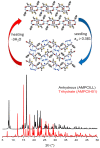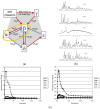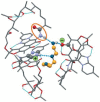The Relevance of Crystal Forms in the Pharmaceutical Field: Sword of Damocles or Innovation Tools?
- PMID: 36012275
- PMCID: PMC9408954
- DOI: 10.3390/ijms23169013
The Relevance of Crystal Forms in the Pharmaceutical Field: Sword of Damocles or Innovation Tools?
Abstract
This review is aimed to provide to an "educated but non-expert" readership and an overview of the scientific, commercial, and ethical importance of investigating the crystalline forms (polymorphs, hydrates, and co-crystals) of active pharmaceutical ingredients (API). The existence of multiple crystal forms of an API is relevant not only for the selection of the best solid material to carry through the various stages of drug development, including the choice of dosage and of excipients suitable for drug development and marketing, but also in terms of intellectual property protection and/or extension. This is because the physico-chemical properties, such as solubility, dissolution rate, thermal stability, processability, etc., of the solid API may depend, sometimes dramatically, on the crystal form, with important implications on the drug's ultimate efficacy. This review will recount how the scientific community and the pharmaceutical industry learned from the catastrophic consequences of the appearance of new, more stable, and unsuspected crystal forms. The relevant aspects of hydrates, the most common pharmaceutical solid solvates, and of co-crystals, the association of two or more solid components in the same crystalline materials, will also be discussed. Examples will be provided of how to tackle multiple crystal forms with screening protocols and theoretical approaches, and ultimately how to turn into discovery and innovation the purposed preparation of new crystalline forms of an API.
Keywords: co-crystals of active pharmaceuticals; crystal polymorphism; hydrates.
Conflict of interest statement
The authors declare no conflict of interest.
Figures
































Similar articles
-
Pharmaceutical solvates, hydrates and amorphous forms: A special emphasis on cocrystals.Adv Drug Deliv Rev. 2017 Aug 1;117:25-46. doi: 10.1016/j.addr.2017.03.002. Epub 2017 Mar 22. Adv Drug Deliv Rev. 2017. PMID: 28342786 Review.
-
High-throughput crystallization: polymorphs, salts, co-crystals and solvates of pharmaceutical solids.Adv Drug Deliv Rev. 2004 Feb 23;56(3):275-300. doi: 10.1016/j.addr.2003.10.020. Adv Drug Deliv Rev. 2004. PMID: 14962582 Review.
-
A Comprehensive Insight on Pharmaceutical Co-crystals for Improvement of Aqueous Solubility.Curr Drug Targets. 2023;24(2):157-170. doi: 10.2174/1389450124666221114095400. Curr Drug Targets. 2023. PMID: 36380409 Review.
-
Use of a glutaric acid cocrystal to improve oral bioavailability of a low solubility API.Pharm Res. 2006 Aug;23(8):1888-97. doi: 10.1007/s11095-006-9032-3. Pharm Res. 2006. PMID: 16832611
-
Pharmaceutical co-crystals-an opportunity for drug product enhancement.Expert Opin Drug Deliv. 2009 Apr;6(4):333-41. doi: 10.1517/17425240902828304. Expert Opin Drug Deliv. 2009. PMID: 19348603 Review.
Cited by
-
A review of research methods for elucidating the microstructure of pharmaceutical preparations.J Pharm Anal. 2025 May;15(5):101156. doi: 10.1016/j.jpha.2024.101156. Epub 2024 Nov 26. J Pharm Anal. 2025. PMID: 40496067 Free PMC article. Review.
-
NMR Crystallographic Investigation Coupled with Molecular Dynamics Simulations Reveals the Nature of Disorder in Chlorpromazine Hydrochloride Solvatomorphs.Mol Pharm. 2025 Aug 4;22(8):4693-4707. doi: 10.1021/acs.molpharmaceut.5c00269. Epub 2025 Jul 19. Mol Pharm. 2025. PMID: 40682806 Free PMC article.
-
Crystal Polymorph Search in the NPT Ensemble via a Deposition/Sublimation Alchemical Path.Cryst Growth Des. 2024 Mar 9;24(8):3205-3217. doi: 10.1021/acs.cgd.3c01358. eCollection 2024 Apr 17. Cryst Growth Des. 2024. PMID: 38659664 Free PMC article.
-
The good, the bad, and the ugly of metals as antimicrobials.Biometals. 2024 Jun;37(3):545-559. doi: 10.1007/s10534-023-00565-y. Epub 2023 Dec 19. Biometals. 2024. PMID: 38112899 Free PMC article. Review.
-
Ionic Levothyroxine Formulations: Synthesis, Bioavailability, and Cytotoxicity Studies.Int J Mol Sci. 2023 May 16;24(10):8822. doi: 10.3390/ijms24108822. Int J Mol Sci. 2023. PMID: 37240166 Free PMC article.
References
-
- Mitscherlich E. Sur la relation qui existe entre la forme cristalline e le proportions chimiques, I. Memoires sur les arseniates et les phosphates. Ann. Chim. Phys. 1822;19:350–419.
-
- McCrone W.C. Physics and Chemistry of the Organic Solid State. In: Fox D., Labes M.M., Weissenberg A., editors. Physics Today. 2nd ed. Volume 2. Interscience; New York, NY, USA: 1965. 725p
-
- Bernstein J. Polymorphism in Molecular Crystals. 2nd ed. Oxford University Press; Oxford, UK: 2020.
-
- Brittain H.G., editor. Polymorphism in Pharmaceutical Solids. 2nd ed. Informa Healthcare; London, UK, USA: 1999.
-
- Hilfiker R., Von Raumer M., editors; Hilfiker R., Von Raumer M., editors. Polymorphism in the Pharmaceutical Industry: Solid Form and Drug Development. 2nd ed. Wiley-VCH; Weinheim, Germany: 2019.
Publication types
MeSH terms
Substances
LinkOut - more resources
Full Text Sources
Other Literature Sources

